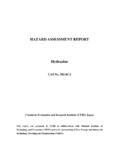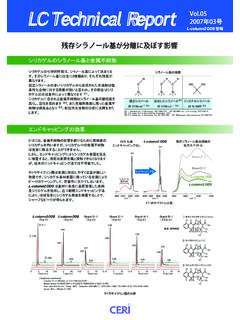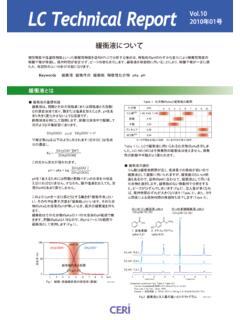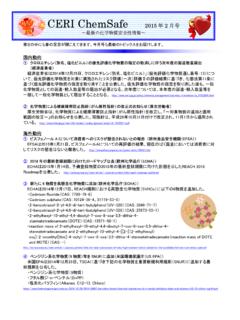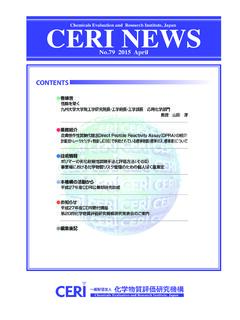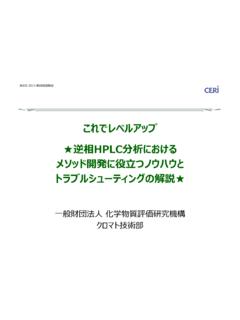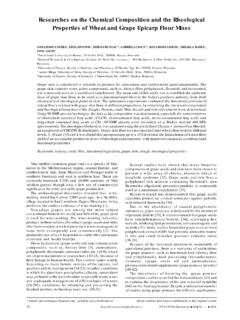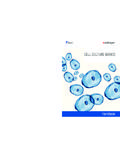Transcription of HAZARD ASSESSMENT REPORT - cerij.or.jp
1 HAZARD ASSESSMENT REPORT N, N-Dimethylformamide CAS No. 68-12-2 Chemicals Evaluation and Research Institute (CERI), Japan This REPORT was prepared by CERI in collaboration with National Institute of Technology and Evaluation (NITE) under the sponsorship of New Energy and Industrial Technology Development Organization (NEDO). iiPreface to the English Version of the HAZARD ASSESSMENT Reports For six years from April 2001 to March 2007, Chemicals Evaluation and Research Institute (CERI/Japan) was engaged in a project named Chemical Risk ASSESSMENT and Development of Risk ASSESSMENT Methods under "Comprehensive Chemical Substance ASSESSMENT and Management Program" funded by New Energy and Industrial Technology Development Organization (NEDO/Japan).
2 Under this project, about 150 chemical substances were selected among those designated as Class-I Chemicals in the Law for Pollutant Release and Transfer Register and Promotion of Chemical Management (hereafter PRTR Law)1). The selection criteria of these chemicals were their priorities for risk ASSESSMENT based on their production levels and environmental/human health concerns. CERI developed the HAZARD ASSESSMENT reports of these selected chemical substances based on the review and evaluation of the environmental and human health HAZARD data obtained from the existing evaluation documents released by the regulatory agencies and international organizations as well as those from the published scientific literatures.
3 The data review and compilation of the reports were conducted according to the guidelines2) and the guidance manual2) developed for this project. The proposed HAZARD ASSESSMENT reports by CERI were reviewed by the experts in the relevant scientific fields from both inside and outside this project for accuracy, relevance and completeness. The final reports were published in Japanese after going through the deliberation by the Council on Chemical Substances under the Ministry of Economy, Trade and Industry (METI/Japan), which is responsible for regulation of chemical substances in Japan.
4 This project was the first attempt in Japan to develop comprehensive HAZARD assessments of chemical substances for application in risk ASSESSMENT . In order to share the outcomes of the project globally, CERI independently selected the following seven chemical substances and developed the English version of the HAZARD ASSESSMENT reports: (1) Acetaldehyde (2) Chlorobenzene (3) Hydrazine (4) N, N-Dimethylformamide (5) Poly(oxyethylene) nonylphenyl ether (6) 3,3 -Dichloro-4,4 -diaminodiphenylmethane (7) Dimethyl 2,2-dichlorovinyl phosphate (Dichlorvos) We hope that the HAZARD ASSESSMENT reports from our project contribute to the risk ASSESSMENT and management of chemical substances globally, and appreciate your feedback.
5 1) Details of the PRTR Law, the list of designated chemical substances, and release data in Japan are available on Internet at: 2) Guidelines and the guidance manual in Japanese are available on Internet at: Also, the initial risk ASSESSMENT reports in Japanese developed in this project which include calculations of margin of exposure based on the result of HAZARD ASSESSMENT and exposure ASSESSMENT , are available on Internet at: iii Date: May, 2007 Chemicals Evaluation and Research Institute 1-4-25 Koraku, Bunkyo-ku, Tokyo 112-0004, Japan ivSummary N, N-Dimethylformamide is a colorless or slightly yellow liquid with a boiling point of 153 C and a vapor pressure of 380 Pa at 20 C.
6 It is freely soluble in water and soluble in alcohols, acetone and benzene. N, N-Dimethylformamide is used as solvent, catalyst and gas absorbent. Sums of domestic production and import levels of N, N-dimethylformamide were 63,043 and 57,724 tons in of 2001 and 2002, respectively. Considering the uses of N, N-dimethylformamide and based on the annual emission data for 2001 in Japan (the 2001 PRTR data), the main release route is considered through emissions in the use process of N, N-dimethylformamide and products containing N, N-dimethylformamide.
7 As the scenario of N, N-dimethylformamide releases in Japan, it is estimated that 24,951 tons of N, N-dimethylformamide was released annually in air and 1,137 tons in water. N, N-Dimethylformamide released into the aquatic environment is eliminated mainly by biodegradation. It is considered that volatilization from the environmental water is low. Low bioaccumulation is suggested in aquatic organisms. Many studies have been conducted to assess the toxic effects of N, N-dimethylformamide on organisms in the environment using indices including mortality, immobilization and growth inhibition.
8 In a growth inhibition study of N, N-dimethylformamide in algae, the EC50 values ranged from 1,000 to 8,900 mg/L in freshwater algae. As the long-term toxicity of N, N-dimethylformamide to algae, the lowest value was 940 mg/L as the 96-hr NOEC for growth inhibition of a freshwater alga. The acute toxicity of N, N-dimethylformamide to invertebrates has been reported in freshwater water flea and midge and the 48-hr LC50 and EC50 (immobilization) values exceeded 1,000 mg/L.
9 The long-term toxicity of N, N-dimethylformamide in the water flea has been reported and the 21-day NOEC for reproductivity ranged 1,000 to 1,500 mg/L. In fish, reliable acute toxicity data of N, N-dimethylformamide to freshwater fish are available in fathead minnow, Japanese killifish, bluegill, and rainbow trout, and the 96-day LC50 values of these species ranged from 7,100 to 10,600 mg/L, and the lowest value was 7,100 mg/L in bluegill. The long-term toxicity of N, N-dimethylformamide in Japanese killifish has been reported and the 21-day NOEC for growth was more than 102 mg/L.
10 No reliable reports were obtained to evaluate effects of N, N-dimethylformamide on marine species. The lowest value of toxicity in aquatic organisms is 940 mg/L as the 96-day NOEC for growth inhibition of the freshwater alga among the confirmed toxicity values. In humans and experimental animals, N, N-dimethylformamide is rapidly absorbed via oral, inhalation and dermal routes. In human inhalation studies, the blood concentrations of unchanged N, N-dimethylformamide were rapidly decreased and not detected in 2 to 4 hours after exposure.
